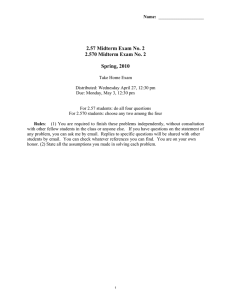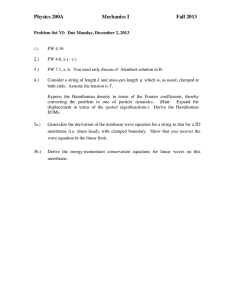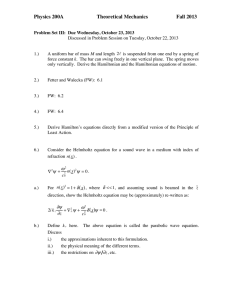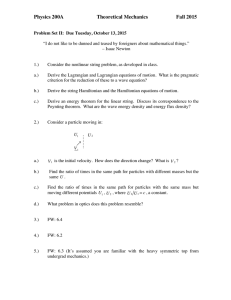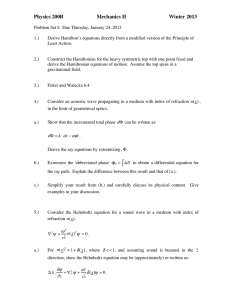Document 13445210
advertisement
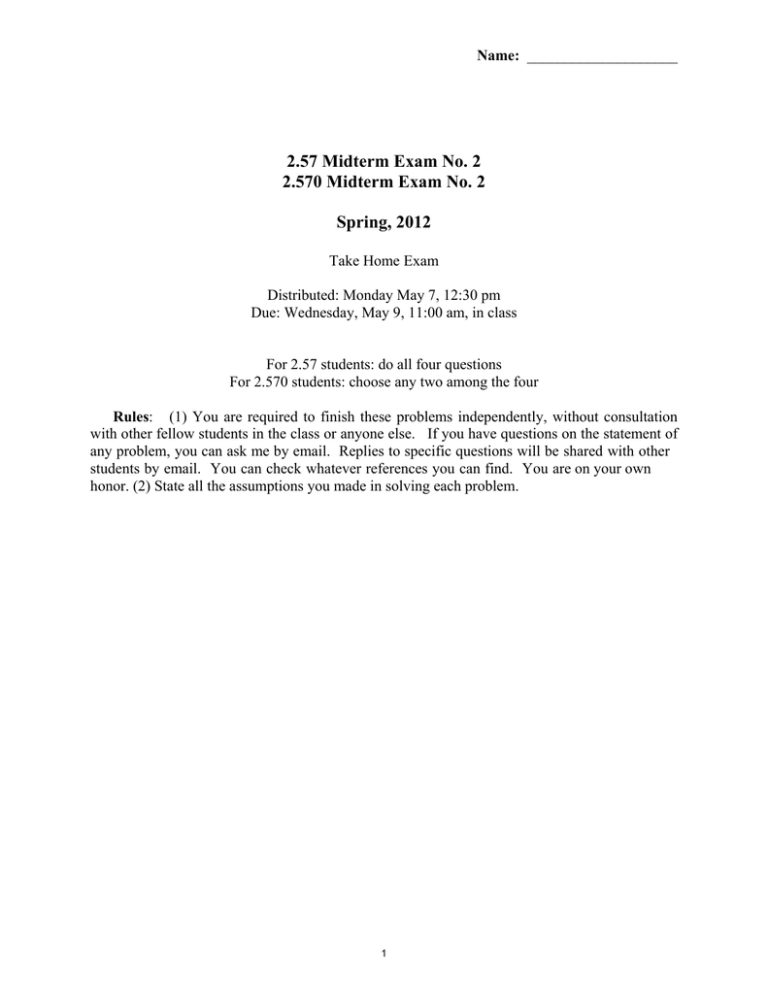
Name: 2.57 Midterm Exam No. 2 2.570 Midterm Exam No. 2 Spring, 2012 Take Home Exam Distributed: Monday May 7, 12:30 pm Due: Wednesday, May 9, 11:00 am, in class For 2.57 students: do all four questions For 2.570 students: choose any two among the four Rules: (1) You are required to finish these problems independently, without consultation with other fellow students in the class or anyone else. If you have questions on the statement of any problem, you can ask me by email. Replies to specific questions will be shared with other students by email. You can check whatever references you can find. You are on your own honor. (2) State all the assumptions you made in solving each problem. 1 Name: 1. Thermal Conductance of a Molecular Chain Heterojunction. Consider a onedimensional atomic chain. The atomic chain is made of two parts as shown in the following figure. One the left side, the atoms have a mass m. On the right hand side, the atoms have a different mass M. The spring constant, K, and interatomic spacing, a, are identical on the two sides, respectively. The chain is connected to a large heat source and a large heat sink maintained at two different temperatures Th and Tc. We further make the following assumptions: (1) atoms vibrate along the chain direction only (longitudinal waves), (2) no phonon-phonon scattering in the atomic chain, (3) phonon transmittance between heat source or sink and their corresponding connected chain is unity, and (4) large number of atoms exist on each segment of the atomic chain. (a) Derive an expression for the phonon transmittance of the atomic chain from the hot to the cold side. (b) Derive an expression for the thermal conductance of the atomic chain. Dispersion relations: k a k a K K 2 sin , 2 sin r m 2 M 2 2 Name: 2. Surface plasmons. The relation between the wavevector and frequency of an electromagnetic wave can be written as k k k 2 x 2 y 2 z 2 co2 Consider now the interface between a vacuum (1=1) and a metal. The metal dielectric constant can be approximated as p 2 2 1 2 where p is called plasmon frequency. Note that when is smaller than p, the dielectric constant becomes negative. We want to show that at the interface between vacuum and metal, a surface wave exists when <p. Our first step is to show that such an interface is 100% reflecting, i.e., no external wave can be coupled to the surface. Then, we will show that a surface wave can still exist, although fields of such a surface wave decays exponentially on both sides of the interface. Consider a TM plane wave (ky=0), the electric field components for the incident, reflected, and transmitted fields can be expressed as Exi ,0, E zi exp- it - (k x x k z1 z (incident) E xr ,0, E zr exp- it - (k x x k z1 z (reflected) Ext ,0, E zt exp- it - (k x x k z 2 z (transmitted) Note that we have used Snell law in expressed the reflected field (kx does not change on both sides). (a) Using Maxwell equations and the orthogonality of wavevector and E field, show that the magnetic field can be expressed as 0, 12 Exi,0 exp - i t - (k x x k z1 z co k z1 0, 12 Exr ,0 exp - i t - (k x x k z1 z co k z1 0, 22 Ext ,0 exp - i t - (k x x k z 2 z co k z 2 (incident) (reflected) (transmitted) (b) Derive an expression for reflectance and show that when <p, the metal is 100% reflecting. 3 Name: (c) Next, we will show that when total reflection happens, there could still exist a surface wave at the interface. This surface wave decays exponentially on both sides of the interface. For this purpose, you can neglect the incident wave, and use the reflected and transmitted wave forms to represent the two waves decaying away from the interface. Show that the relationship between kx and is kx co 1 2 1 2 Note that when 1+2=0, kx approaches infinite. This is the surface plasmon resonance condition. 4 Name: 3. Thermal conductivity of graphene nanoribbon. Consider phonon heat conduction along a graphene (single atomic layer thick). We assume that there are three acoustic phonon branches in the atomic sheet and their dispersions are identical, given by ω vk v k 2x k 2y The effective lattice constant is a. We also assume that phonons in the sheet have a constant relaxation time (a) Derive an expression for the corresponding Fourier law for heat conduction along the sheet plane. (b) Derive an expression for the phonon thermal conductivity along the sheet plane. (c) Now consider that the graphene sheet is cut into a narrow ribbon of width d and d is comparable to the phonon mean free path. Assume phonons are scattered diffusely at the boundaries of the ribbon, derive an expression for the effective thermal conductivity of the graphene. 5 Name: 4. Lorentz Number of Nondegenerate Semiconductors. semiconductor with parabolic band and isotropic effective mass, E E c Consider a nondegenerate 2 (k x2 k y2 k z2 ) 2m Assume that the electron relaxation time is constant and independent of the energy, and that doping per unit volume (n) is light such that Boltzmann statistics can be assumed, i.e, f 1 E exp k T B (a) Derive an expression for the chemical potential in the semiconductor, (b) Derive an expression for the electrical conductivity of the semiconductor, (c) Derive an expression for the electronic contribution to the thermal conductivity, (d) Derive an expression for the Lorentz number All of the derived expression should be in terms of the given parameters and physical constants. 6 MIT OpenCourseWare http://ocw.mit.edu 2.57 / 2.570 Nano-to-Macro Transport Processes Spring 2012 For information about citing these materials or our Terms of Use, visit: http://ocw.mit.edu/terms.
